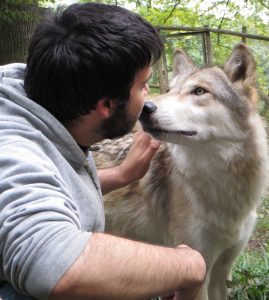Contributed by Len McKenzie —
 Wolves hold a prominent place in both human history and the human psyche. Integral to that history were the ecological relationships they evolved over time on the earth’s continental land masses.
Wolves hold a prominent place in both human history and the human psyche. Integral to that history were the ecological relationships they evolved over time on the earth’s continental land masses.
American and Eurasian folklore and literature are replete with characterizations and imagery of wolves, usually negative (remember “Little Red Riding Hood” and “Three Little Pigs?”).
Wolves once roamed North America from the Arctic to Mexico, fulfilling their vital role as keystone predators that ecologically regulated the numbers in prey populations and sustained a predator-prey balance. By the early 1900s, loss of habitat and wanton extermination had extirpated wolves from most of their range, including California.
The National Park Service (NPS), established in 1916, contributed to the decimation by systematically removing predators from their native habitats under its former misbegotten policy of protecting elk and other “benign” prey species from predation.
In 1973, the U. S. Fish and Wildlife Service listed the northern Rocky Mountain gray wolf as an endangered species under the provisions of the then-new Endangered Species Act and designated three wolf recovery areas. About that same time the NPS officially changed its wildlife management policies, recognizing that balanced natural systems are ecologically healthier and more sustainable than manipulated systems that favor individual species and led to overpopulations.
From 1995 – 1997 the NPS and other federal agencies reintroduced 41 wild wolves from Canada and Montana into Yellowstone National Park. Wolf packs soon dispersed into adjacent areas, making them more vulnerable to human-caused mortality, but the park continues to offer assurance of long-term viability of the population and opportunities for research.
Petros Chrysalis, a Fresno State University graduate student, will examine wolf issues in California, including their possible reappearance in Yosemite, in a slide presentation, “The History, Status and Potential Future of Wolves in California,” at the Yosemite Area Audubon Society’s (YAAS) monthly program Thursday, Mar. 8, at 7 p.m. at the New Community United Methodist Church on Road 426 in Oakhurst.
Petros’ talk will draw from scientific literature as well as personal experiences, addressing not only the potential for wolves to repopulate Yosemite but also their possible return to the Central Valley.
Petros graduated with a BSc(Hons) in zoology from the University of Aberdeen, Scotland. During his undergraduate studies he was involved in various projects around the Scottish Highlands, such as monitoring red deer herds and their reactions to predator vocalization, the effect of human presence on seal haulout behavior and the public response to a wolf reintroduction.
He also worked in Europe on projects such as establishing new monitoring and survey methods for the Cyprus red fox population. During his last year he participated in conservation efforts to reduce wolf attacks on livestock dogs in Greece, implementing experimental non-lethal methods of deterring livestock depredation by wolves in the Balkans and studying captive wolfpack behavior at the Wolf Science Center in Austria.
Petros is currently studying the effect of development on mammal use of the riparian habitat in the San Joaquin River as part of his Masters (MS Biology) project.
Like all YAAS programs, Petros’ presentation is open and free to the public, although donations to defray program costs and to support Audubon’s local activities are welcome.
Call (209) 742-5579 or visit www.yosemiteaudubon.org for more information about the program.
YAAS will also offer a field trip to the Three Springs Land Trust in North Fork on Saturday, Mar. 24. Participants should meet at 8:30 a.m. at the Bass Lake Ranger Station behind the market on Grizzly Road in “downtown” North Fork to carpool to the site.
The walk of one to three miles will be on moderate terrain and will end about noon or early afternoon. Rain cancels. Bring binoculars, field guides, water, snacks, sunscreen and a hat, and wear sturdy, comfortable shoes.
Contact Susanjoy at joycoyote@yahoo.com or (516) 512-0171 for more information.
The mission of the National Audubon Society, the namesake of noted 19th-century naturalist and bird painter John James Audubon; its state affiliate, Audubon California; and local chapters such as the Yosemite Area Audubon Society is to conserve and restore natural ecosystems, focusing on birds, other wildlife and their habitats for the benefit of humanity and the earth’s biological diversity.



